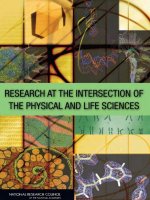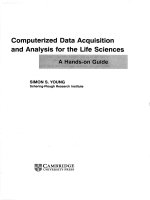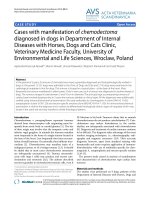Animal life cycles (life sciences)
Bạn đang xem bản rút gọn của tài liệu. Xem và tải ngay bản đầy đủ của tài liệu tại đây (2.09 MB, 10 trang )
Life Sciences
Standards
Preview
Standard Set 2. Life Sciences
2. Plants and animals have
predictable life cycles. As a basis for
understanding this concept:
2.b. Students know the sequential
stages of life cycles are different for
different animals, such as butterflies,
frogs, and mice.
Genre
Nonfiction
Comprehension Skill
State the Purpose
Text Features
• Captions
• Labels
• Glossary
Science Content
Animal Life Cycles
Scott Foresman Science 2.4
ISBN 0-328-23503-2
ì<(sk$m)=cdfadc< +^-Ä-U-Ä-U
by Nancy Day
Vocabulary
amphibian
insect
larva
life cycle
mammal
pupa
tadpole
Picture Credits
Every effort has been made to secure permission and provide appropriate credit for photographic material. The
publisher deeply regrets any omission and pledges to correct errors called to its attention in subsequent editions.
Unless otherwise acknowledged, all photographs are the copyright of Dorling Kindersley, a division of Pearson.
ISBN: 0-328-23503-2
Copyright © Pearson Education, Inc. All Rights Reserved. Printed in the United States of America.
This publication is protected by Copyright, and permission should be obtained from the publisher prior to any
prohibited reproduction, storage in a retrieval system, or transmission in any form by any means, electronic,
mechanical, photocopying, recording, or likewise. For information regarding permission(s), write to
Permissions Department, Scott Foresman, 1900 East Lake Avenue, Glenview, Illinois 60025.
1 2 3 4 5 6 7 8 9 10 V010 13 12 11 10 09 08 07 06
by Nancy Day
What is
a life cycle?
Living things grow.
Living things change.
This growth and change
is called a life cycle.
Every life cycle has steps or stages.
Animals look different at each stage.
All animals change size.
Many animals change shape.
Some animals change color.
Living things
have life cycles.
Living things
change size.
2
3
Growing and Changing in
Different Ways
A mammal is an animal.
Young mammals look like their parents.
They change size as they grow.
An insect is an animal.
It has three body parts and six legs.
It changes size, color, and shape
as it grows.
An amphibian is an animal.
It lives in water for part of its life.
Young amphibians do not look
like their parents.
They change size, shape,
and color, too.
An adult toad
Bears are mammals.
This is a young toad.
Toads are amphibians.
4
5
What is the life
cycle of a frog?
A frog is an amphibian.
It begins life as an egg.
Some frog eggs float in the water.
A tadpole hatches from the egg.
It swims out.
A tadpole is a very young frog.
The tadpole grows and changes.
It grows back legs first.
Later come the front legs.
The tadpole’s legs get stronger.
Its tail gets smaller.
This tadpole is
nine weeks old.
A frog
egg is tiny.
A tadpole
has a tail.
6
This frog is
twelve weeks old.
7
From Young Frog to Adult Frog
The frog is no longer a tadpole.
It is no longer a young frog.
Now it is an adult.
The adult frog may lay eggs in
the water.
Those eggs might become tadpoles.
Then the life cycle starts over again.
A young
tadpole
An egg
An older
tadpole
An adult frog
8
9
What is the life
cycle of a mouse?
Mice are mammals.
A baby mouse is called a mouse.
It looks like its parents.
But it is much smaller.
It does not have hair.
Newborn mice
10
The mouse grows.
It looks more like its parents.
At last, the mouse is an adult.
It can have baby mice.
Then the life cycle starts over.
Two-week
old mice
Adult mice
11
What is the
life cycle of a
butterfly?
A butterfly is an insect.
It starts life as an egg.
Next, a caterpillar hatches.
A caterpillar is a larva.
A larva is a young insect.
A hard case grows around the
caterpillar.
It is now a pupa.
Out of the pupa comes an adult
butterfly.
It looks nothing like a caterpillar!
egg
pupa
adult
larva
12
13
What is the
life cycle of a
grasshopper?
The nymph has six legs.
It does not have wings.
The nymph grows into an adult.
The adult grasshopper has two pairs
of wings.
A grasshopper is an insect.
It starts as an egg.
The egg hatches.
Out comes a young grasshopper.
It is a nymph.
eggs
nymph
adult
14
15
Glossary
What did you learn?
amphibian an animal that lives part of its
life in water and part on land
1. Go back to what you read about young
insects, mammals, and amphibians. Which
look like their parents? Which do not?
insect
an animal that has three body
parts and six legs
larva
a young insect
life cycle
the way a living thing grows
and changes
mammal
an animal that usually has hair
or fur on its body
pupa
the stage after the larva in some
insects’ life cycles
tadpole
the second stage of a frog’s
life cycle
16
2. What are the four stages of the butterfly’s
life cycle?
3.
Have you seen a cat or
dog grow from a newborn kitten or puppy
to an adult? How did they look after they
were born? When did they start to play?
Who or what did they play with? What did
they eat?
4.
State the Purpose Go back to the
pictures on pages 8 and 9. What is their
purpose for being there?









